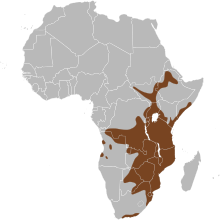Bushpig
| Bushpig | |
|---|---|
 |
|
| Southern bushpig (P. larvatus koiropotamus) at the San Diego Zoo | |
| Scientific classification | |
| Kingdom: | Animalia |
| Phylum: | Chordata |
| Class: | Mammalia |
| Order: | Artiodactyla |
| Family: | Suidae |
| Genus: | Potamochoerus |
| Species: | P. larvatus |
| Binomial name | |
|
Potamochoerus larvatus (F. Cuvier, 1822) |
|
 |
|
The bushpig (Potamochoerus larvatus) is a member of the pig family and lives in forests, woodland, riverine vegetation and reedbeds in East and Southern Africa. Probably introduced populations are also present in Madagascar. There have also been unverified reports of their presence on the Comoro island of Mayotte. Bushpigs are mainly nocturnal. There are several subspecies.
Adult bushpigs stand from 66 to 100 cm (26 to 39 in) at the shoulder, and weigh from 55 to 150 kg (121 to 331 lb). They resemble the domestic pig, and can be identified by their blunt, muscular snouts, small eyes, pointed, tufted ears and buckled toes. Their colour varies from reddish brown to dark brown and becomes darker with age. Both sexes have a lighter-coloured which bristles when the animal becomes agitated. The upper parts of the face and ears are also lighter in colour. Their sharp tusks are fairly short and inconspicuous. Unlike warthogs, bushpigs run with their tails down. Males are normally larger than females.
The bushpig is closely related to the red river hog, Potamochoerus porcus, with which it can interbreed. The bushpig is distinguished by its less colourful markings, coarser hair, and larger size. Many pig populations display physical characteristics intermediate between the two species.
Bushpigs are quite social animals and are found in sounders of up to 12 members. A typical group will consist of a dominant male and a dominant female, with other females and juveniles accounting for the rest. Litters of three to four young are born in summer after a gestation period of approximately four months. Bushpigs can be very aggressive, especially when they have young.
They are omnivorous and their diet could include roots, crops or carrion. They grunt softly while foraging, and make a long, resonant growl as an alarm call. They are a significant nuisance in the agricultural regions of South Africa, and are hunted fairly extensively. However, the population of bushpigs in the farming areas continues to grow despite the hunting efforts, due to the largely inaccessible terrain, abundance of food, lack of predators, and their rapid ability to adapt to hunting methods. In Islamic parts of East Africa, it is a further nuisance because, as it is a pig, it is not permitted to be eaten. Its meat is considerably leaner than pork.
...
Wikipedia

